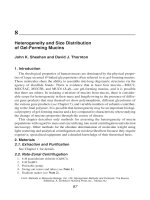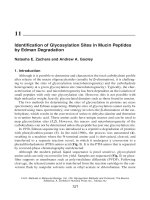Glycoprotein methods protocols - biotechnology 048-9-111-119.pdf
Bạn đang xem bản rút gọn của tài liệu. Xem và tải ngay bản đầy đủ của tài liệu tại đây (101.04 KB, 7 trang )
Amino Acid Analysis of Mucins 113
113
From:
Methods in Molecular Biology, Vol. 125: Glycoprotein Methods and Protocols: The Mucins
Edited by: A. Corfield © Humana Press Inc., Totowa, NJ
10
Amino Acid Analysis of Mucins
Jun X. Yan and Nicolle H. Packer
1. Introduction
Amino acid analysis is a commonly used technique that provides quantitative esti-
mation of the amounts of proteins/amino acids present in a sample and/or qualitative
information on the amino acid composition of a protein. For protein analysis, the tech-
nique essentially involves acid hydrolysis of amino acid peptide bonds within the pro-
tein; chemical derivatization of hydrolysate (amino acids) of the protein; and high-
performance liquid chromatography (HPLC) separation, detection, and analysis of
those derivatized amino acids.
The commercially available amino acid analyzers (e.g., Waters Pico-Tag system
[Waters Corp., Milford, MA]; GBC AminoMate system [GBC Scientific, Dandenong,
Victoria, Australia]) have made amino acid analysis more practical and feasible in
routine protein analysis laboratories. The sensitivity of the analysis has been dramati-
cally increased to low picomole levels of proteins, including those low molecular
weight (10–20 kDa) ones (low amount of total amino acids analyzed) (1).
In this chapter, we describe a 9-fluorenylmethyl oxycarbonyl chloride (FMOC)-
based precolumn derivatization amino acid analysis that has been extensively vali-
dated (1,2). Although the detailed protocols on the use of the automated GBC
AminoMate (GBC Scientific) amino acid analyzer have been described elsewhere (3),
here, we emphasize the procedures that are used in a manual operation. Thus, this
technique can be easily adapted in any laboratory where an HPLC system with a fluo-
rescent detector and gradient controller is available.
Acid hydrolysis is the first and most important step to release the amino acids from
the proteins, and it must be carefully controlled in the analysis of mucins. The acid
hydrolysis described here recovers 16 amino acids (asparagine and glutamine are
deamidated to their corresponding acids, whereas tryptophan and cysteine are destroyed).
During the acid hydrolysis, the carbohydrate side chains on the mucins are degraded.
Because of the high carbohydrate content of mucins (up to 90% of the dry weight), the
sugars can be caramelized and further charcoaled, and the acid hydrolysis results in a
black residue. This residue appears to precipitate protein/amino acids, interferes with
114 Yan and Packer
chromatography, and leads to a significantly lower recovery of all the amino acids,
especially serine and threonine. Strong acid, high temperature, and short time acid
hydrolysis (12 N HCl at 155°C for 1 h) is generally used in our laboratory for less
glycosylated proteins (1). We have found that weaker acid, lower temperature, and
longer time (ensuring the completion of the hydrolysis) acid hydrolysis (6 N HCl at
105°C for 24 h) is a must to obtain reproducible quantitative analysis of mucin gly-
coproteins. The hydrolysate of mucin is then derivatized with Fmoc on the α-amino
groups under alkaline conditions. The derivatized amino acids are separated by a C18
reversed-phase column and detected by fluorescence. Our routine analyses have shown
that the method described here is reliable and useful for both quantitative and
qualitative mucin glycoprotein amino acid analysis.
2. Materials
2.1. Apparatus
2.1.1. Hydrolysis Equipment
1. Hydrolysis vessel: the design can be viewed on the World Wide Web at .
mq.edu.au/APAF (see Note 1).
2. Vacuum pump: Savant Speedvac (Savant Industries, Farmingdale, NY) (or equivalent)
with a vacuum gauge.
3. Two-way line connection to an argon line and a vacuum pump.
4. Autosampler glass vials made from inert Chromacol Gold™ grade glass (Chromacol, cat.
no. 02-MTVWG, Herts, UK).
2.1.2. HPLC System (
see
Note 2)
1. LC-pump with ternary gradient controller.
2. Fluorescence detector: excitation, λ = 270 nm; detection, λ = 316 nm.
3. Sample injector.
4. Degasser: alternatively, buffers can be degassed by continuous flow of helium.
5. Hypersil C18 reversed-phase column: 150 × 4.6 mm inner diameter 5 µm (Keystone,
Bellefonte, PA).
6. In-line filter (2 µm) (Upchurch, cat. no. 100-10).
2.2. Chemicals
2.2.1. Hydrolysis and Derivatization Reagents
1. Hydrochloric acid: constant boiling temperature 6 N (Pierce, cat. no. 24309).
2. Ultrapure phenol (ICN, cat. no. 800672) kept at 4°C.
3. Borate buffer: 250 mM boric acid (analytical reagent grade [AR] grade) in water, adjusted
to pH 8.5 with NaOH. Buffer may be kept up to 1 mo at 4°C.
4. Fmoc reagent: 4 mg/mL fluorenylmethyl chloroformate (Sigma, cat. no. F0378) in aceto-
nitrile (HPLC grade). Reagent may be stored up to 1 wk at 4°C.
5. Cleavage reagent: 680 µL of 0.85 M NaOH (AR grade), 150 µL of 0.5 M hydroxylamine
hydrochloride (Sigma, cat. no. H2391), and 20 µL of 2-methylthio-ethanol (Sigma, cat.
no. M9268). Stock solution can be kept for 1 mo at 4°C. Working cleavage reagent must
be made freshly prior to each use.
6. Quenching reagent: 2 mL of acetic acid (AR grade) and 8 mL of acetonitrile.
Amino Acid Analysis of Mucins 115
2.2.2. Chromatography Reagents
1. Amino acid standards H: protein hydrolysate standard in 0.1 N HCl, containing a solution
of 17 amino acids (Sigma, cat. no. A9781).
2. L-hydroxyproline used as internal standard (Sigma, cat. no. H1637).
3. Phosphate buffer (2 M): 2 M anhydrous ammonium monohydrogen phosphate (AR grade)
solution, adjusted to pH 6.5 with 2 M anhydrous dihydrogen phosphate (AR grade) solu-
tion. Buffer may be kept up to 6 mo at 4°C.
4. Mobile phase A (30 mM ammonium phosphate [pH 6.5]): Into a 1000 mL volumetric
flask, add 15 mL of 2 M phosphate buffer and dilute to volume with mobile phase B.
5. Mobile phase B: 15% (v/v) methanol in water.
6. Mobile phase C: 90% (v/v) acetonitrile in water.
3. Methods
3.1. Sample Preparation and Hydrolysis
1. Add an aliquot of a solution of a sample of mucin into an autosampler glass vial and dry
under vacuum (see Note 3).
2. Place the vials, 400 µL of HCl (6 N), and a crystal of phenol into the bottom of the
hydrolysis vessel.
3. Assemble the vessel tightly. Connect the vessel to a two-way argon and vacuum line.
4. Evacuate the vessel to 3 torr, and flush with argon. Repeat this step twice, and seal the
vessel after the third evacuation step (see Note 4).
5. Place the vessel in a 105°C oven for 24 h.
6. Remove the vessel from the oven and open the vacuum tap immediately within a fume
hood (see Note 4).
7. Place the vials into a vacuum centrifuge for 10 min to evaporate excess HCl.
3.2. Derivatization (
see
Note 5)
1. Dissolve the mucin hydrolysate in 10 µL of 250 mM borate buffer, pH 8.5.
2. Add 10 µL of Fmoc reagent, mix, and then wait 1 min.
3. Add 10 µL of cleavage reagent, mix, and then wait 4 min.
4. Add 10 µL of quenching reagent mix.
3.3. Chromatography (
see
Note 6)
1. Set up the fluorescent detector with excitation λ = 270 nm and detection λ = 316 nm.
2. The mobile phase is a ternary solution system using the gradient shown in Table 1.
3. The stationary phase is a 5 µm Hypersil C18 column that is temperature controlled at
38°C. Flow rate is 1.0 mL/min. Allow the column to equilibrate with two gradient runs
before the sample injection.
4. Inject an aliquot (≥5 µL) of each derivatized sample (see Note 6). Run time is 35 min.
Allow at least 2 min for pump and column equilibration with the initial composition of
the mobile phase.
5. Figures 1 and 2 show typical chromatograms of the separation of amino acid standards
and hydrolyzed bovine conjunctival mucin (10–20 µg).
6. After the run, the peaks can be integrated and the picomoles of each mucin amino acid
calculated by comparison with the peak areas given by the amino acid standard. Since the
total number of amino acids (or the molecular mass) in a mucin glycoprotein is unknown
(or difficult to determine), the actual number of picomoles of mucin protein cannot be
determined by this analysis. In practice, the amount of mucin can usually be referred to as
116 Yan and Packer
Table 1
Gradient for the Baseline Separation
of 16 Fmoc–Derivatized Amino Acids Within 35 min
% Mobile phase A % Mobile phase B % Mobile phase C
Time (30 mM ammonium (15% [v/v] (90% [v/v]
(min) phosphate, pH 6.5) methanol/water) acetonitrile/water)
017 68 15
117 68 15
32 10.8 43.2 46
32.05 0 0 100
34 0 0 100
34.05 17 68 15
35 17 68 15
Fig. 1. Typical chromatogram of separation of 16 standard Fmoc-amino acids. RFU = rela-
tive fluorescence units; Amino acid code: D = aspartic acid, E = glutamic acid, HP = hydroxy
proline, S = serine, H = histidine, G = glycine, T = threonine, A = alanine, P = proline,
Y=tyrosine, R = arginine, V = valine, M = methionine, I = isoleucine, L = leucine, F =
phenylalanine, K = lysine.
the amount or ratio of certain amino acids, so a relative comparison in quantitative analy-
sis, e.g., carbohydrate analysis, can be done. The amino acid composition of the mucin
(%pmol) = pmol of mucin amino acid/total pmol of total amino acids x 100% (see Table 2
for an example) (see Note 7).
Amino Acid Analysis of Mucins 117
4. Notes
1. The hydrolysis vessel can be made by any glassblower. It has to withstand high tempera-
ture in the presence of strong acid vapor, and hold positive and negative gas pressure
during each hydrolysis run.
2. The detection of amino acids can be achieved by any HPLC system. However, if Fmoc is
used as the derivatization reagent, a fluorescence detector is essential. The HPLC must
consist of a ternary gradient controller in order to run the gradient program necessary for
the baseline separation of 16 amino acids. We have investigated different types of C18
reversed-phase column and have found that the Hypersil C18 column manufactured by
Keystone provides the best separation and resolution. We use the GBC automated
AminoMate HPLC system controlled by GBC WinChrom Windows software that pro-
vides an automatic integration of the chromatogram and assignment of peaks (3).
3. Sample preparation is an important step in amino acid analysis. Ideally, samples should
be dried and free of salts, amines, and detergents. The sample of mucin must be desalted
(e.g., by using a size-exclusion desalting column), or the mucin can be dot-spotted onto
polyvinylidene difluoride (PVDF) membrane, or gel separated by electrophoresis and
electroblotted onto PVDF. Note that mucins are often difficult to bind to PVDF. Wilkins
et al. (3) have described a detailed protocol for PVDF-bound protein samples.
4. During the evacuation and argon flush of the hydrolysis vessel, the bottom of the vessel
will become cold and the acid will boil under vacuum. These are the signs that the vessel
is sealed tightly. Following hydrolysis, the vessel should be opened as soon as it is
removed from the oven. Acid condensation inside the vessel is an indication of a com-
plete hydrolysis. Handling the vessel requires heat-resistant gloves, and safety goggles
must be worn at all times.
Fig. 2. Typical chromatogram of separation of amino acids from bovine conjunctival mucin
hydrolysate. RFU = relative fluorescence units. Amino acid code as defined in Fig. 1.









